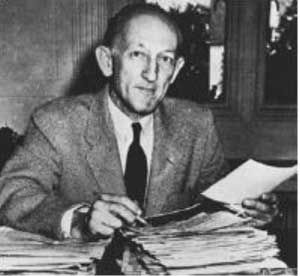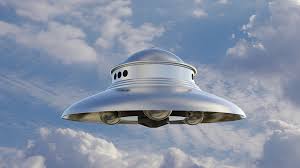If it’s not too bizarre a claim to make in the context of a cultural field as marginal and questionable, in ufology Donald Keyhoe is a monumental figure. No history of the UFO can overlook his contributions as a researcher and activist, as director of the National Investigations Committee on Aerial Phenomena (NICAP) and one of the first and most forceful figures to press for Congressional hearings into the question of the UFO, arguably inaugurating similar, continuing efforts on the part of today’s Disclosure movement. What’s telling, either about the UFO as such or Keyhoe’s insight into the phenomenon, is the the way his original conclusions set forth in his article for True Magazine “The Flying Saucers are Real” and his book of the same title, both published in 1950, continue to set the ufological agenda.
In line with the USAF’s own reasoning, Keyhoe posited what is now known as the Extraterrestrial Hypothesis (ETH), that UFOs are spaceships of interplanetary origin. Keyhoe and the Air Force arrived at this conclusion by a process of elimination. Some of the reported sightings could not be explained away as misidentifications or hoaxes; neither the American military nor any of its allies or enemies possessed the aeronautical technology to produce aeroforms with the flight characteristics of the disks, nor did it make sense that if the disks were experimental aircraft that they would be tested in ways that might allow this new weapon to be observed or even captured or that threatened civilian life and limb and that had actually resulted in the death of one airman, Thomas Mantell; therefore, since no conventional, earthly explanation existed to explain these uncanny flying machines, they were most likely of extraterrestrial origin. This argument in support of the ETH is repeated to this day.
The ETH found further support and elaboration in matching the patterns of reported sightings to speculations about how humankind might explore inhabited planets in the future with the result that the way the story of the flying disks had developed to this point mirrored the way human beings would proceed with their own explorations. This projection of an imagined human future behaviour also extended to the disks’ extraterrestrial origin: the pilots’ technology must be in advance of our own, given what their ships can do and how far they must have traveled to have reached earth from some distant planet if not, as was thought more likely, star. That is, their intelligence is an anthropomorphic one, that, like our own, proceeded along a path of tool-using, technological development. At work here is a fateful generalization and failure of imagination that posits human intelligence as singular and archetypal and the radically contingent history of industrial civilization as typical of intelligent beings. Such a projection of the “human form divine” finds its culmination in Keyhoe’s finding himself unable to picture the extraterrestrials as anything other than anthropomorphic, because of
the stubborn feeling that they would resemble man. That came, of course, from an inborn feeling of man’s superiority over all living things. It carried over into the feeling that any thinking, intelligent being, whether on Mars or Wolf 359’s planets, should have evolved in the same form. (The Flying Saucers are Real, 136)
These anthropocentric and technocentric prejudices remain as operative in much of the UFO imaginary as they go unremarked.
An equally persistent set of concerns orbits the potentially disruptive consequences of the revelation of the reality of extraterrestrial, technologically advanced civilizations having appeared in our skies. Keyhoe mulling this matter over with his editor as they prepare to publish his article for True Magazine reflects that “public acceptance of intelligent life on other planets would affect almost every phase of our existence—business, defense planning, philosophy, even religions” (139), a supposition that inspires the 300+ pages of Richard M. Dolan’s and Bryce Zabel’s 2012 book A.D. After Disclosure: When the Government Finally Reveals the Truth About Alien Contact.
More acutely, in the wake of the purported reaction to Orson Welles’ 1938 War of the Worlds radio broadcast, many feared the most immediate reaction to the news would be widespread panic. These considerations guide the development of official reaction to the phenomenon. As Keyhoe saw it, the USAF first set out to “investigate and at the same time conceal from the public the truth about the saucers” (173). Then “it was decided to let the facts gradually leak out, in order to prepare the American people.” However, “the unexpected public reaction [to the True Magazine article] was mistaken by the Air Force for hysteria, resulting in their hasty denial that the saucers existed.” The problem of just what to reveal and conceal concerning the saucers was also complicated by Cold War national security issues. As Keyhoe saw it
The education problem is complicated by two imperative needs. We must try to learn as much as we can about the space ships’ source of power, and at the same time try to prevent clues to this information from reaching an enemy on earth. (174)
Here are nascent themes in ufological speculation that persist and have been developed to the present day. First is the belief that militaries and governments around the world have or continue to investigate UFOs. Secondly, their efforts have borne fruit in determining the (usually extraterrestrial) truth of the phenomenon. Thirdly, because of the explosive nature of these discoveries, those who hold these secrets dissimulate concerning the phenomenon to dissuade serious, public interest and to maintain either the potential or real technological advantage these secrets bestow, or, alternatively, they are engaged in a process of public education through a combination of leaks, disinformation, and popular culture (such as movie and television) to prepare society for the ultimate revelation of the reality of the extraterrestrial presence.
 Hand in hand with this motif is that of the insider able to access this otherwise secret or tactfully unpublicized information, a figure that has morphed, today, into the whistleblower. Keyhoe, as an ex-Marine pilot, maintained many contacts within the military and government. Most of the narrative of his books is conversations he has with these inside sources. The final chapters of The Flying Saucers are Real find Keyhoe studying over two hundred secret Air Force files released to him and his petitioning a general of his acquaintance for the more than one hundred he had been denied! This figure with access to inside information undergoes a change as the official relation to the phenomenon (at least in its public guise) develops from secrecy, to debunkery, to indifference. The truth is no longer obtained via official documents from official channels, but via leaked or hacked documents or whistleblower, witness testimony.
Hand in hand with this motif is that of the insider able to access this otherwise secret or tactfully unpublicized information, a figure that has morphed, today, into the whistleblower. Keyhoe, as an ex-Marine pilot, maintained many contacts within the military and government. Most of the narrative of his books is conversations he has with these inside sources. The final chapters of The Flying Saucers are Real find Keyhoe studying over two hundred secret Air Force files released to him and his petitioning a general of his acquaintance for the more than one hundred he had been denied! This figure with access to inside information undergoes a change as the official relation to the phenomenon (at least in its public guise) develops from secrecy, to debunkery, to indifference. The truth is no longer obtained via official documents from official channels, but via leaked or hacked documents or whistleblower, witness testimony.
Two other dimensions of the UFO myth appear in Keyhoe’s first book. At one point, an informant tells him that he has learned that the flying disks are British secret weapons developed from German plans and prototypes captured at the end of the Second World War (122).  Here, the myth of the Nazi flying saucer, arguably first popularized by Holocaust denier Ernst Zündel as a money-making scheme but since elaborated perhaps most fully by Joseph Farrell, makes very likely its first appearance in print. Moreover, although, tellingly, the Roswell incident is not mentioned in The Flying Saucers are Real, another of Keyhoe’s informants relates to him a story about “little men from Venus”:
Here, the myth of the Nazi flying saucer, arguably first popularized by Holocaust denier Ernst Zündel as a money-making scheme but since elaborated perhaps most fully by Joseph Farrell, makes very likely its first appearance in print. Moreover, although, tellingly, the Roswell incident is not mentioned in The Flying Saucers are Real, another of Keyhoe’s informants relates to him a story about “little men from Venus”:
In the usual version, two flying saucers had come down near our southwestern border. In the space craft were several oddly dressed men, three feet high. All of them were dead; the cause was usually given as inability to stand our atmosphere. The Air Force was said to have hushed up the story… (139)
The source of this particular story is given as George Koehler (165), who later admits to its being “a gag”. But the rumour also brings to mind a more famous fabrication by Frank Scully, whose Behind the Flying Saucers is published the same year as Keyhoe’s first book. Regardless of who first invents this scenario, we find here the vector for what will be called Crash/Retrieval Syndrome, a string of increasingly elaborate stories concerning crashed and retrieved flying saucers and the capture of their pilots, dead or alive, that will bloom with the rediscovery of the Roswell Crash and subsequently flower into a wildly variegated myth of reverse-engineered alien technology, secret treaties between various ET races and earth governments, breakaway civilizations, exopolitics and disclosure, a term that perhaps appears for the first time in the UFO literature in Keyhoe’s important first volume.
Addendum: …and just to be clear
Some readers might be tempted to take this post as a panegyric to Keyhoe. My purpose, however, was to outline how even his earliest ufological publications set the ufological agenda to this day.
Most ufology, arguably, adheres to the anthropocentric ETH Keyhoe sets out. The social repercussions of the truth of the ETH are likewise seen to be still as acute and wide ranging. For this reason, the motives to maintain secrecy around private and state research into and discoveries concerning UFOs and ETs are the same Keyhoe saw. The way this secrecy is breached has changed since Keyhoe’s day, as I note, but the basic patterns of disclosure (Keyhoe’s word) are still affirmed. Moreover, the myths of Nazi flying saucers and Crash/Retrieval Syndrome are still with us, however much in more developed forms than the nascent ones present in The Flying Saucers Have Landed.
Why ufology should remain static in this way is itself a question that demands to be looked into….






 Hand in hand with this motif is that of the insider able to access this otherwise secret or tactfully unpublicized information, a figure that has morphed, today, into the whistleblower. Keyhoe, as an ex-Marine pilot, maintained many contacts within the military and government. Most of the narrative of his books is conversations he has with these inside sources. The final chapters of The Flying Saucers are Real find Keyhoe studying over two hundred secret Air Force files released to him and his petitioning a general of his acquaintance for the more than one hundred he had been denied! This figure with access to inside information undergoes a change as the official relation to the phenomenon (at least in its public guise) develops from secrecy, to debunkery, to indifference. The truth is no longer obtained via official documents from official channels, but via leaked or hacked documents or whistleblower,
Hand in hand with this motif is that of the insider able to access this otherwise secret or tactfully unpublicized information, a figure that has morphed, today, into the whistleblower. Keyhoe, as an ex-Marine pilot, maintained many contacts within the military and government. Most of the narrative of his books is conversations he has with these inside sources. The final chapters of The Flying Saucers are Real find Keyhoe studying over two hundred secret Air Force files released to him and his petitioning a general of his acquaintance for the more than one hundred he had been denied! This figure with access to inside information undergoes a change as the official relation to the phenomenon (at least in its public guise) develops from secrecy, to debunkery, to indifference. The truth is no longer obtained via official documents from official channels, but via leaked or hacked documents or whistleblower,  Here, the myth of the Nazi flying saucer, arguably first popularized by Holocaust denier
Here, the myth of the Nazi flying saucer, arguably first popularized by Holocaust denier 
